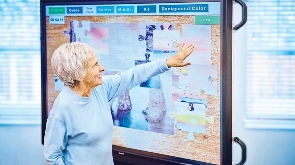Dementia is a complex neurological condition that profoundly affects individuals’ lives, challenging their cognitive abilities and altering their daily routines. While there is currently no cure for dementia, technology offers a glimmer of hope and potential for significant improvements in the quality of life for both individuals with dementia and their caregivers. By harnessing the power of innovation, technology provides a range of tools and solutions designed to address the unique challenges and needs associated with dementia.
From cognitive stimulation and reminders to safety monitoring and assistive devices, technology is transforming the landscape of dementia care. These technological advancements offer opportunities for engagement, support, and empowerment, enabling individuals with dementia to maintain independence, enhance cognitive function, and foster meaningful connections with their loved ones and the world around them. By understanding and embracing the possibilities technology presents, we embark on a journey towards a more compassionate, inclusive, and fulfilling approach to dementia care. Here are some ways in which technology can be beneficial:
Cognitive stimulation
Cognitive stimulation holds tremendous potential in dementia care, providing hope and enriching the lives of those affected by this condition. By actively engaging and challenging their cognitive abilities, we can create meaningful and enjoyable experiences that foster mental well-being. Through thoughtfully designed activities like memory exercises, puzzles, and interactive games, cognitive stimulation acts as a catalyst for awakening and maintaining cognitive function.
It promotes memory recall, enhances attention and concentration, and nurtures creative thinking. Beyond exercising the brain, these activities instill a sense of accomplishment, boosting self-esteem and confidence. However, cognitive stimulation goes beyond preserving cognitive abilities alone. It also encourages social interaction, offering opportunities for individuals with dementia to connect with their loved ones, friends, and caregivers. Engaging in group activities or participating in virtual communities becomes a powerful antidote to combat loneliness and isolation, fostering a sense of belonging and emotional well-being.
In dementia care, cognitive stimulation is not merely about slowing cognitive decline; it is about maximizing quality of life. It helps individuals maintain their sense of identity, purpose, and independence. By tailoring activities to their unique interests, hobbies, and personal history, we honor their individual experiences and strengths, fostering empowerment and fulfillment.
Caregivers and healthcare professionals play a crucial role in providing cognitive stimulation by creating a supportive and engaging environment. With patience, empathy, and understanding, they can adapt activities to suit each individual's abilities and preferences, ensuring a positive and enriching experience. Cognitive stimulation serves as a beacon of hope throughout the challenging journey of dementia.
It illuminates minds, ignites connections, and celebrates the inherent resilience of individuals living with this condition. By embracing cognitive stimulation in dementia care, we unlock the potential for enhanced well-being, meaningful engagement, and a more fulfilling life.
Reminders and prompts
Reminders and prompts play a vital role in dementia care, offering invaluable support and guidance to individuals facing memory loss challenges. These simple yet profound tools empower both individuals with dementia and their caregivers by preserving routines, fostering independence, and promoting overall well-being. Memory lapses can disrupt daily activities and cause frustration or anxiety for those with dementia.
Reminders and prompts act as gentle nudges, bridging the gap between memory impairment and the successful completion of essential tasks. Whether it’s medication management, appointments, or self-care routines, these tools ensure important responsibilities are not overlooked. Technology, such as smartphones, smartwatches, and specialised reminder systems, contributes significantly in this area.
These devices can be programmed to send timely alerts, providing individuals with dementia gentle reminders for various activities. Such digital companions alleviate caregiver burden and promote a sense of self-sufficiency.
Beyond their practicality, reminders and prompts contribute to a sense of security and structure. They offer reassurance and a feeling of control, allowing individuals to maintain aspects of their normal lives.
By reducing uncertainty and confusion, these tools can alleviate anxiety and foster a more relaxed state of mind. Caregivers also benefit greatly from reminders and prompts, as they can better manage their time and energy, knowing that important tasks are being addressed. This lightens the burden on caregivers, enabling more meaningful interactions and quality time with their loved ones. Additionally, reminders and prompts provide peace of mind, knowing that critical aspects of care are being managed effectively.
Personalising reminders and prompts is crucial to align them with the individual's preferences and needs. Tailoring the approach to their unique routines, habits, and communication style ensures maximum effectiveness. Sensitivity and patience are key, as these tools should never feel intrusive or overwhelming but instead serve as gentle guides on the journey.
Safety monitoring
One of the main concerns in dementia care is the risk of accidents, such as falls or wandering. Safety monitoring systems act as watchful guardians, using advanced sensors and devices to detect and alert caregivers or emergency services in case of emergencies. These systems quickly inform caregivers of any irregularities, allowing for immediate intervention to prevent harm. For individuals with dementia who may wander, safety monitoring becomes essential in tracking their whereabouts.
GPS tracking devices, combined with smart home technology, provide a way to ensure their safety while still maintaining a level of independence. Caregivers receive real-time notifications if a loved one ventures outside predefined safe areas, enabling them to take immediate action and bring them back to safety. Safety monitoring goes beyond physical well-being and can also assist in monitoring other aspects of health. Smart home devices equipped with motion sensors can detect changes in activity patterns, sleep disruptions, or deviations from daily routines.
This information is invaluable in identifying potential health issues or notifying caregivers of significant behavioral changes. Safety monitoring not only protects individuals with dementia but also offers much-needed respite for caregivers. The constant vigilance required can be emotionally and physically draining, leading to significant stress. Safety monitoring systems alleviate this burden, giving caregivers peace of mind to attend to other responsibilities, practice self-care, and reduce stress levels.
Implementing safety monitoring systems must prioritize privacy and dignity. Open communication and collaboration with individuals with dementia and their families are essential to ensure that monitoring methods align with personal preferences and cultural sensitivities. Striking a balance between safety and autonomy is crucial, preserving the individual’s dignity while providing necessary protection.
Assistive devices
Assistive devices come in various forms, ranging from simple gadgets to more advanced technologies, all designed to meet the unique needs of people with dementia. Assistive devices like automatic pill dispensers can provide timely reminders and help organize medication schedules, ensuring that individuals with dementia take their medications correctly and on time. This not only reduces the risk of medication errors but also improves their overall health and safety. Communication can be another area of difficulty for individuals with dementia, but assistive devices can make a significant difference.
Picture-based communication tools, speech-to-text software, and voice-activated assistants enable individuals to express their needs, desires, and emotions more effectively. These devices help bridge the communication gaps caused by cognitive decline, allowing individuals to engage in meaningful conversations, connect with loved ones, and maintain social connections. Assistive devices also contribute to safety and security in dementia care. Smart home technology, for example, can automate various tasks such as lighting, temperature control, and door locks, creating a safe and comfortable living environment. Motion sensors and alert systems can detect potential dangers like fire or intrusions, promptly notifying caregivers or emergency services, which helps mitigate risks and provides peace of mind.
Independence in daily activities is essential for individuals with dementia, and assistive devices can assist in maintaining that independence. Whether it’s adaptive utensils, grab bars, or wearable devices with fall detection capabilities, these tools simplify tasks like cooking, personal hygiene, and dressing, allowing individuals to retain a sense of autonomy and self-sufficiency. Caregivers also benefit greatly from assistive devices. These tools lighten the caregiving load, enabling caregivers to focus more on providing emotional support and fostering meaningful connections with their loved ones. By streamlining caregiving tasks, improving efficiency, and reducing stress levels, assistive devices contribute to the overall well-being of both caregivers and individuals with dementia.
Communication and socialisation
Communication lies at the core of our human experience, and its significance in dementia care cannot be overstated. While cognitive decline may affect language and comprehension, there are various strategies and tools available to facilitate effective communication. Patience, active listening, and non-verbal cues help bridge the gaps and connect with individuals in a meaningful way. Simple gestures, gentle touch, and maintaining eye contact can convey love, empathy, and understanding when words become challenging. Technology also plays a crucial role in enhancing communication for individuals with dementia.
Video calling applications like WhatsApp Call, Zoom meeting, Skype or FaceTime enable connections with loved ones, regardless of distance, fostering a sense of togetherness and reducing feelings of loneliness. Social media platforms and online support groups offer opportunities for interaction and engagement, allowing individuals to share experiences, seek advice, and build a sense of community. Socialization is equally important as it nurtures a sense of belonging and combats the isolating effects of dementia. Group activities such as art therapy, music programs, or memory cafes create environments where individuals can connect with others who share similar experiences.
These settings encourage friendships, self-expression, and positive emotions, ultimately enhancing well-being and quality of life. Engaging individuals with dementia in meaningful social interactions also stimulates cognitive function and helps maintain a sense of identity. Group discussions, reminiscence therapy, or participation in community events tap into personal histories and evoke cherished memories. Through these shared experiences, individuals feel valued, acknowledged, and connected to their past and present. Caregivers and healthcare professionals play a crucial role in facilitating communication and socialization.
They create supportive environments that encourage engagement, adapt activities to individual preferences, and provide gentle guidance when needed. By embracing a person-centered approach, where the individual’s needs, interests, and abilities are respected, caregivers foster an atmosphere of trust and empowerment, allowing individuals with dementia to express themselves authentically.
Final words
In conclusion, the potential of technology in enhancing dementia care is vast and transformative. From cognitive stimulation and reminders to safety monitoring and assistive devices, technology offers innovative solutions to address the unique challenges faced by individuals with dementia and their caregivers. By harnessing the power of technology, we can create personalized experiences that promote engagement, independence, and well-being. Moreover, technology opens doors to communication and socialization, allowing individuals with dementia to connect with their loved ones and build meaningful relationships.
As we embrace the digital age, we embark on a journey towards a more compassionate and empowering approach to dementia care. By integrating technology into our strategies and interventions, we can unlock the full potential of individuals with dementia, enhancing their quality of life and ensuring they are seen, heard, and valued every step of the way.
Opinions of Tuesday, 23 May 2023
Columnist: Daniel Naawenkangua Abukuri















